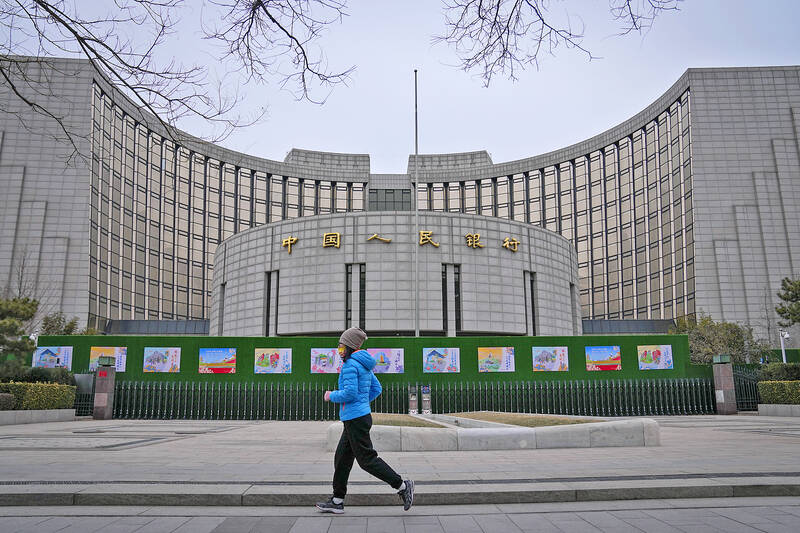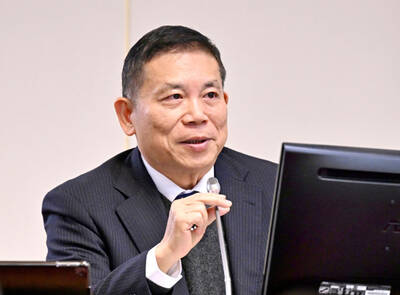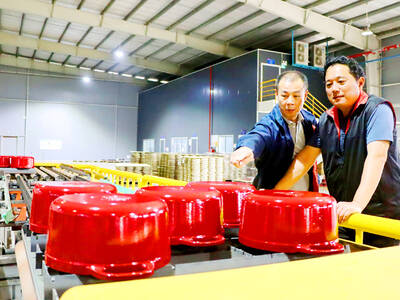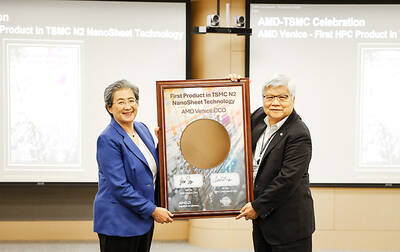China yesterday ramped up support for its property sector with its biggest-ever cut to a key mortgage reference rate, raising expectations for more aggressive measures to support the economy in the months to come.
Chinese lenders slashed their five-year loan prime rate (LPR) by 25 basis points to 3.95 percent, the People’s Bank of China said.
It was the first cut since June last year and the largest reduction since a revamp of the rate was rolled out in 2019.

Photo: AP
Lowering that rate will allow more cities in China to reduce minimum mortgage rates for homebuyers, which might stimulate sluggish demand for apartments as prices fall. The move shows an intensifying focus on measures to combat the property crisis, which has been a major drag on the world’s second-largest economy.
“It is delivering stronger dose of easing to the economy,” said Michelle Lam (林雪潔), an economist at Societe Generale SA.
The cut might reflect more support for mortgage demand and long-term corporate loans “while reducing risks of idle use of funds,” Lam said.
Banks also maintained their one-year LPR — the de facto benchmark lending rate — at 3.45 percent.
While expectations for a smaller reduction in the five-year LPR were fairly widespread, economists were split on a one-year LPR cut.
The move failed to impress investors.
China’s benchmark CSI 300 Index was down about 0.3 percent in morning trade. The offshore yuan gained 0.1 percent as the central bank set a strong daily reference rate, while the currency traded onshore was unchanged. Yields on China’s government bonds — which have been falling on greater bets for easing — slipped 1 basis point to 2.43 percent.
“A bigger cut may boost housing sentiment in the near-term, though this unlikely marks a turnaround in the property sector,” said Alex Loo, a macro strategist at TD Securities in Singapore.
Loo cited the China’s “urgency” to entice more homebuyers as property sales in key cities slumped during the week-long Lunar New Year holiday.
Next month is traditionally a peak season for home sales, making any efforts to spur more purchases all the more timely.
Even so, it was not clear whether the five-year LPR cut would offer much of a boost. The average rate of new mortgages granted in December last year had already fallen to a record low of 3.97 percent, while mega-cities such as Beijing, Shanghai and Guangzhou have been relaxing curbs on home purchases for months.
The cut will probably provide the most benefit for new homebuyers right now, as many existing mortgages — which were worth 38 trillion yuan (US$5.28 trillion) at the end of last year — are only repriced at the beginning of the year.
Several economists pointed to the need for additional easing this year — including through cuts to the central banks one-year policy loan rate, or the medium-term lending facility rate.
The People’s Bank of China refrained from lowering that rate on Sunday, making yesterday’s action the first time since May 2022 that the five-year LPR rate was cut following a hold on the medium-term lending facility rate.
The LPRs are based on the interest rates that 20 banks offer their best customers and are quoted as a spread over the central bank’s medium-term lending facility rate.
The central bank, which publishes the LPRs monthly, is seen as having significant sway over them.

UNCERTAINTY: Innolux activated a stringent supply chain management mechanism, as it did during the COVID-19 pandemic, to ensure optimal inventory levels for customers Flat-panel display makers AUO Corp (友達) and Innolux Corp (群創) yesterday said that about 12 to 20 percent of their display business is at risk of potential US tariffs and that they would relocate production or shipment destinations to mitigate the levies’ effects. US tariffs would have a direct impact of US$200 million on AUO’s revenue, company chairman Paul Peng (彭雙浪) told reporters on the sidelines of the Touch Taiwan trade show in Taipei yesterday. That would make up about 12 percent of the company’s overall revenue. To cope with the tariff uncertainty, AUO plans to allocate its production to manufacturing facilities in

Taiwan will prioritize the development of silicon photonics by taking advantage of its strength in the semiconductor industry to build another shield to protect the local economy, National Development Council (NDC) Minister Paul Liu (劉鏡清) said yesterday. Speaking at a meeting of the legislature’s Economics Committee, Liu said Taiwan already has the artificial intelligence (AI) industry as a shield, after the semiconductor industry, to safeguard the country, and is looking at new unique fields to build more economic shields. While Taiwan will further strengthen its existing shields, over the longer term, the country is determined to focus on such potential segments as

TAKING STOCK: A Taiwanese cookware firm in Vietnam urged customers to assess inventory or place orders early so shipments can reach the US while tariffs are paused Taiwanese businesses in Vietnam are exploring alternatives after the White House imposed a 46 percent import duty on Vietnamese goods, following US President Donald Trump’s announcement of “reciprocal” tariffs on the US’ trading partners. Lo Shih-liang (羅世良), chairman of Brico Industry Co (裕茂工業), a Taiwanese company that manufactures cast iron cookware and stove components in Vietnam, said that more than 40 percent of his business was tied to the US market, describing the constant US policy shifts as an emotional roller coaster. “I work during the day and stay up all night watching the news. I’ve been following US news until 3am

COLLABORATION: Given Taiwan’s key position in global supply chains, the US firm is discussing strategies with local partners and clients to deal with global uncertainties Advanced Micro Devices Inc (AMD) yesterday said it is meeting with local ecosystem partners, including Taiwan Semiconductor Manufacturing Co (TSMC, 台積電), to discuss strategies, including long-term manufacturing, to navigate uncertainties such as US tariffs, as Taiwan occupies an important position in global supply chains. AMD chief executive officer Lisa Su (蘇姿丰) told reporters that Taiwan is an important part of the chip designer’s ecosystem and she is discussing with partners and customers in Taiwan to forge strong collaborations on different areas during this critical period. AMD has just become the first artificial-intelligence (AI) server chip customer of TSMC to utilize its advanced